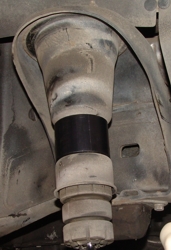OK, spent some time this morning to take measurements and drawings.
The first is a drawing showing the axle housing from the side. The red is the axle bracket that the control arm bolts to. The Yellow is the axle housing. The gray is the pinion and the blue is the pinion flange. The relationship of the bolt holes where the arm bolts to, axle center line, pinion position, pinion angle to bracket angle and pinion distance from axle center line is all to scale as best I can measure it.
The wireframe shows how the axle is rotated when the Slee caster plates are installed and it is rotated around the back bolt. The amount of rotation is correct based on our design of the caster plates.
The next is a blow up of the pinion area showing the measurements. The one we are intersted in is the backward movement. This shows the center of the pinion to have moved back .49"
This is the same sketch with the axle rotated around the center as Rick does with his caster plates. The rotation of the axle was set to the same as ours (since I do not know how much he rotates).
This is the overall drawing
and this is the detail close-up
From this you can see that the pinion actually moved back .33" So the total difference in pinion movement is 0.16". That is less than 3/16 of an inch. One could debate a little as to what direction the movement is measured in, but I think this is clear enough that there is very little movement difference between the two methods.
It is important to remember that this only shows what happens with the axle housing in relation to the arm in free space. To model the complete effect, one has to add the control arm and the mount to the frame on the vehicle. This will affect the net movement of any of the components.











